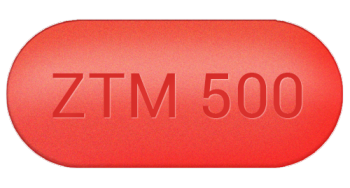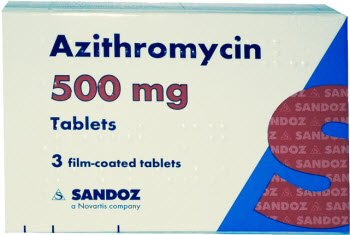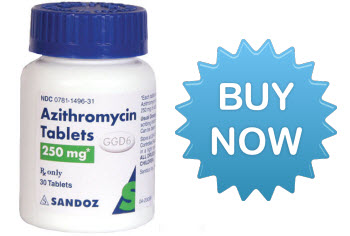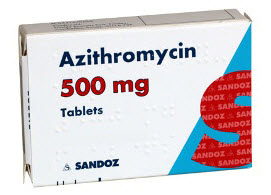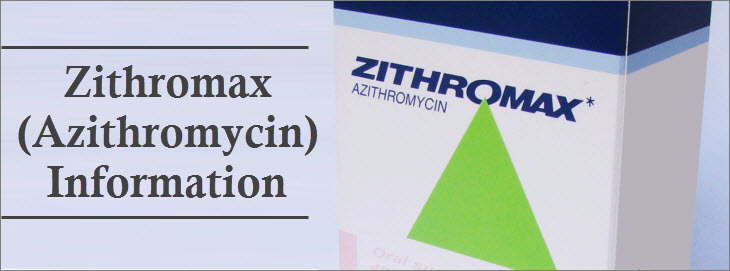
Azithromycin Information. Pharmacokinetics, prices, order online
Contents
- Azithromycin tablets
- Azithromycin 250mg. Zithromax capsules 250mg
- Azithromycin buy online. Azithromycin purchase
- How much is Azithromycin?
- Azithromycin without prescription
- Azithromycin effects and features
- Azithromycin superdrug antibacterial activity
- Azithromycin Pharmacokinetics
- Azithromycin uses and clinical application
Azithromycin tablets
Azithromycin tablets are used to kill virulent microorganisms and eliminate the symptoms of inflammation. It is a white powder, sealed in a soluble capsule of 250 or 500 mg. Also, the medicine Azithromycin is available in tablets or syrup. The tablet contains 125 mg of the active ingredient. Azithromycin is rapidly adsorbed in the gastric tract, as it is resistant to acidic conditions. The maximum concentration of the drug is observed after 2.5-3 hours after administration.
The antibiotic Azithromycin is highly penetrating. After ingestion, it can be found in the respiratory tract, urogenital system, skin, muscle tissue. Therefore, Azithromycin tablets are prescribed for the treatment of pathologies of the upper respiratory tract, urinary system, skin diseases. After taking Azithromycin, it continues for 5-7 days, so doctors prescribe it for a short course, because after the last use, the medicine can destroy the infection for another week. Removal of the drug takes place in the range of 20-72 hours, so Azithromycin is used 1 time per day.
Azithromycin has proven itself to be an effective antibiotic in the treatment of angina, bronchitis and other upper respiratory infections, as well as respiratory diseases. It is used on an outpatient basis, as an effective drug from most strains of pathogens, since it is not possible to wait for the results of laboratory tests. A feature of Azithromycin tablets is their prolonged action, therefore, this antibiotic is prescribed in a short course once a day. The drug Azithromycin gives a good result when applied at different stages of the disease.
Azithromycin 250mg. Zithromax capsules 250mg
Many diseases of infectious etiology are treated with antimicrobial agents. Doctors often use a broad-spectrum antibiotic, since virulent microorganisms have some resistance to most antimicrobial agents. What does Azithromycin 250mg treat – it described in detail in the instructions for its use. But it should be remembered that each organism is individual. Therefore, before being treated with antibiotics, you should consult with your doctor, because the drugs in this group have some side effects.
Azithromycin 250mg capsules belong to the macrolide group. The drug is different effects on most gram-positive and gram-negative bacteria. Microorganisms resistant to erythromycin are resistant to it. A characteristic feature of Azithromycin 250mg capsules is their ability to concentrate in the affected tissues and act on pathogenic microbes there. Azithromycin is available in capsules of 100, 250 and 500 mg containing the same active ingredient as well as auxiliary ingredients.
The main advantages of Azithromycin 250mg capsules
Azithromycin 250mg has a wide spectrum of action and is destructive for most species of bacteria, but the drug is not effective against fungi or viruses;
Azithromycin capsules are used to treat bacterial infections: ENT organs, upper respiratory tract and urinary system;
After taking Azithromycin 250mg capsules after 1 hour, the destruction of microorganisms begins, and after 6 hours the maximum concentration of the active ingredient is noted in the pathological focus, which persists for up to 5 days;
A general improvement in well-being is noted for 2-3 days after the start of drug therapy;
Azithromycin is approved for use in early childhood (from 4 months) in the form of suspensions and syrups.
Azithromycin buy online. Azithromycin purchase
Where can I buy Azithromycin on the Internet?
In order to buy the drug Azithromycin (Zithromax) online and save time searching for a pharmacy, you can use our partner’s popular and trusted online pharmacy. Link below:
Next, we will tell you about the nuances when buying Azithromycin and other drugs in urban and online pharmacies.
Of course, such a significant segment of the health care system as the sale of medicines cannot do without state control. The requirements for companies selling drugs are very strict and partly depend on the type of online pharmacy.
Therefore, having a license says a lot: it’s not just paper, it’s a guarantee that the pharmacy complies with safety standards. If you have any doubts about the reliability of the pharmacy, you can always ask to show the license and check its authenticity in the corresponding registry on a special website.
How to choose a pharmacy to buy Azithromycin: search for the best option
Among the variety of online pharmacies is not so easy to find the right one. At the same time, it is very important that Azithromycin is available, and that online pharmacies be qualified and pleasant to talk to. It is also important that the prices for Azithromycin are lower than those of competitors.
1. Internet aggregators. A definite plus of aggregator sites is that they allow you to find specific drugs in pharmacies, and also to find out in which company Azithromycin is cheaper. Aggregators offer installation of the application on a smartphone, which finds the nearest points of sale of the medicine, based on the location of the user.
2. Independent search of pharmacy. The most difficult and time-consuming method is to independently search for the drug Azithromycin through pharmacy websites through call-ups in pharmacies, as well as from reviews of friends. However, this method has its advantages in comparison with the previous one: it allows you to find out the prices and find rare drugs in companies that do not participate in ratings, are not registered in aggregators, and sometimes do not even have an Internet site. In general, the method of searching for the drug Azithromycin depends entirely on the goal: the cheapest pharmacies can be found through aggregator sites, the quality of service can be judged by ratings and reviews, but to search for very rare medicines you will have to arm yourself with a phone and turn to the search engine and directories.
Where can I buy medicine Azithromycin cheaper?
As practice shows, you can save on the purchase of the drug Azithromycin, if you know and follow some rules:
1. Farther from the center. In large cities, the cost of renting space on central streets is significantly higher than in residential areas. This means that drugs in the central pharmacies will cost more than in the outskirts of the city, even when sold within the same network.
2. Learn about the availability of discounts on Azithromycin. Many pharmacies, especially online pharmacies, offer discounts of up to 10% on the social card, some pharmacies offer you to purchase a discount card, arrange promotions and sales for individual medicines.
3. The Internet will reduce costs. Many online pharmacies work on the same principle as economy stores. Moreover, the online showcase allows you to further reduce the cost of renting the premises: all expensive and rare products are stored in a common warehouse and arrive at the receiving point as orders arrive. Saving a customer buying medicine at an online pharmacy can be up to 25%.
How much is Azithromycin?
How much does Azithromycin (Zithromax) cost? Azithromycin prices may vary. It all depends on where you buy this drug. Prices in ordinary pharmacies may be higher than in online pharmacies. Also, the price of Azithromycin may depend on where the city pharmacy is located, in the city center or on the outskirts.
Below we show you the cost of Azithromycin capsules in the online pharmacy of our partner. For more information about the prices and dosages of the drug, you can find on the official website of the online pharmacy, the link is located at the beginning of this article.
| 60 pills | 120 pills | 270 pills | 360 pills | |
|---|---|---|---|---|
| Azithromycin 500mg | $104 | $164 | $313 | $402 |
| Azithromycin 250mg | $70 | $117 | $236 | $307 |
| Azithromycin 100mg | $43 | $66 | $122 | $156 |
Azithromycin without prescription
You can order Azithromycin without a prescription, without leaving your home or office, and then receive it by mail or courier to your home.
In online pharmacies where you can order Azithromycin without a prescription, the price of the drug you are looking for is usually lower than in most of the regular online city pharmacies. And if the price still seems high to you, then you can search for a cheaper drug.
The main advantage of ordering Azithromycin online is the absence of the need to present a prescription.
The recipe means that you have to go to the doctor, and the doctor is a waste of time, perhaps a turn, the need to take time off from your work. And in the online pharmacy - there is no prescription and no problem. With the exception of certain categories of drugs, you can purchase, for example, the antibiotic Azithromycin you need. However, you should understand that self-medication is fraught with chronic disease and other troubles.
Azithromycin effects and features
Azithromycin is an azalide representative - a subclass of macrolide antibiotics. Chemically it differs from the presence of macrolide 15-membered lactone ring containing a nitrogen atom. In the arsenal of antibacterial agents for the treatment of respiratory infections, azithromycin always maintains a leading position: depending on the nosology of it is used as a first-line drug, an alternative agent or in combination with other antibiotics. This is due to a number of exceptional features of azithromycin, is what sets it apart from other antibacterial agents.
Azithromycin superdrug antibacterial activity
Azithromycin superdrug has a broad spectrum of antibacterial activity, which covers the majority of bacterial species that cause respiratory tract infections. The drug is effective against Gram-positive organisms, including producing β-lactamase (streptococci, staphylococci) and Gram-negative bacteria (enterococci, Escherichia coli, Haemophilus influenzae, Shigella, Salmonella), atypical pathogens (Chlamydia pneumoniae, Legionella pneumophila, Mycoplasma pneumoniae) , anaerobes and spirochetes. Azithromycin is 2-4 times less active against streptococci and staphylococci than erythromycin, but surpasses it in effects on Haemophilus influenzae and Gram negative cocci. A positive feature of azithromycin superdrug is a low level of resistance of microorganisms to it.
Azithromycin Pharmacokinetics
Azithromycin has unique pharmacokinetic characteristics: first, a high degree of accumulation in tissues and in cells where its levels are 10-100 times higher than in blood plasma. This property is due to the highly lipophilic drug. The maximum concentration of azithromycin is determined in lung tissue (compared to erythromycin, had no marked differences in the level of blood plasma and in the lungs). Due to the accumulation of azithromycin in phagocytes drug is distributed in pockets of infectious inflammation. The concentration of azithromycin in the foci of infection was significantly higher than in unaffected tissues.
Azithromycin is inherent metabolic stability. He works for a long time (half-life 2-4 days.), With postantibioticski effect (maintenance of effective concentrations at the site of infection within 3-5 days after discontinuation of the drug) against S.pyogenes, S.pneumoniae, H.influenzae, L.pneumophila. Duration postantibioticski effect in relation to H.influenzae L.pneumophila and azithromycin in higher than that of clarithromycin. This exclusive feature makes the use of azithromycin in the treatment of respiratory tract infections - the effectiveness of 3-5-day course of treatment.
The blood-brain barrier drug does not penetrate. Elimination occurs in the urine in unchanged form with bile. In renal failure and hepatic elimination half-life is not changed. The drug has no effect on the liver microsomal system, therefore, there is no risk of unwanted effects specific to the interaction.
In the US, created and introduced into clinical practice of new oral dosage form of azithromycin - sustained-release microspheres (SG). Office of the Food and Drug US funds (FDA) approved the use of azithromycin for the treatment of pollutants CAP and light / moderate sinusitis in a single dose for the course. As compared with conventional dosage form azithromycin pollutants slowly absorbed in the intestine, the maximum plasma concentration is reached after 2.5 hours and the bioavailability was 82.8%. The use of azithromycin is characterized by SG lower incidence of dyspeptic disorders. Concurrent use of antacids has no significant effect on the pharmacokinetic parameters of azithromycin pollutants (maximum plasma concentration, area under the concentration-time curve). The introduction of azithromycin pollutants allowed not only to achieve high efficiency of antibiotic therapy, but also to increase compliance: drug is given once, has a favorable safety and tolerability profile.
Azithromycin uses and clinical application
Azithromycin was widely justified in the treatment of respiratory system pathologies. This is due to favorable spectrum of antibacterial activity, low resistance thereto pathogens pharmacokinetic characteristics (high pulmonary depozitsiya) and good tolerability.
In a comparative study of azithromycin, amoxicillin / clavulanate and cefuroxime, erythromycin combination with community-acquired pneumonia set to the same clinical efficacy comparable conditions, but azithromycin characterized by better tolerability and a lower incidence of adverse effects (12%). In the group treated combined with cefuroxime erythromycin, frequency of adverse effects was 48% (mainly diarrhea symptoms). When comparing pharmacoeconomic empirical treatment with azithromycin or erythromycin combination with cefuroxime in sequential therapy set equivalent value of these modes of modes (while reducing costs in the azithromycin group was not taken into account due to the lower incidence of adverse effects, therapeutic process simplification and reduction of staff time).
Azithromycin in addition to other macrolide antibiotics is the drug of choice for treatment of atypical (Mycoplasma, Legionella, Chlamydia) pneumoniae. According to some data, the share of these intracellular pathogens account for over 30% of all cases of community-acquired pneumonia, and verification of these pathogens requires the use of expensive procedures. In this regard, the empirical use of azithromycin in the treatment of community-acquired pneumonia is reasonable. In severe pneumonia justified empiric combination with azithromycin ceftriaxone.
A new form of azithromycin (microspheres sustained release) was applied in a single dose of 2 g for the course for the empirical treatment of community-acquired pneumonia and bacterial sinusitis mild to moderate severity. A single dose of azithromycin was comparable in efficiency with the use of levofloxacin and clarithromycin for 7 days in community-acquired pneumonia or levofloxacin for 10 days with sinusitis. The use of a new form of azithromycin showed a high compliance and tolerability.
Justified the appointment of azithromycin as the drug of choice for treatment of exacerbations of chronic bronchitis, agents which are usually S.pneumoniae, M.catarrhalis, H.influenzae. The use of other macrolides considered inappropriate because of the absence of clinically significant activity against H.influenzae.
Long-term use of low-dose azithromycin in cystic fibrosis patients with chronic Pseudomonas aeruginosa infection was accompanied by a decrease in the number of exacerbations, the positive effect on pulmonary function, improvement in nutritional status and well-tolerated drug.
Interest are the data on the properties of organo azithromycin, which may be caused by non-specific anti-inflammatory activity and antioxidant activity of azithromycin. For example, one study demonstrated that azithromycin protects against lung injury induced by smoking. Azithromycin inhibits damage caused by tobacco smoke alveolocytes type II, the activation of nuclear factor k and an increase in the concentration of tumor necrosis factor a. This action, of course, is an advantage of the antibiotic in the treatment of bronchopulmonary diseases.
Is of independent interest data on the use of azithromycin for the treatment of infectious processes at other sites: urogenital chlamydia, syphilis, chronic bacterial prostatitis (in combination with ciprofloxacin), acne, Lyme disease, chronic periodontitis.
Conclusion
The unique pharmacokinetic characteristics (tissue storage, metabolic stability, characteristic exclusively for azithromycin long half-life), a wide spectrum of antibacterial activity including atypical pathogens presence postantibiotic effect tolerability, high compliance, low resistance agents, the presence of organo properties (antiinflammatory and antioxidant activity) - all this gives grounds for the widespread use of azithromycin for respiratory infections. The clinical efficacy of azithromycin in empiric treatment of bronchopulmonary infections (alone or in combination with β-lactam) outpatient and inpatient demonstrated in several multicenter trials.
